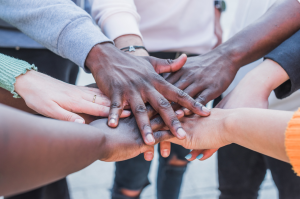First Things First
Biases are the tendencies or inclinations we have in favour of or against a thing, person or group. They are a de facto part of the human experience. We, and by extension our biases, are largely shaped and informed by our individual experiences with power, belonging, privilege or lack thereof. As our identity forms, our biases develop alongside it; for this reason we should not be afraid to admit that we do, in fact, have biases. What we should do is forthrightly examine them.
The Meterstick
We use what we know of ourselves and our own experiences as a baseline by which we form ideas, opinions and judgements of others. This process of making judgements of people against ourselves is not all bad, despite the connotations of the word ‘judgement.’ As we seek to embody the values of diversity, equity, inclusion and belonging, we tend to recoil at the thought of admitting we’re judgemental; they seem to be at odds with each other. But, think about the way you make friends, or enter intorelationships; consider how we prioritise connections with those who share our interests, opinions, likes and dislikes. Looking for commonalities between ourselves and strangers is the basis on which we form social groups and communities.
From early on in our development as individuals, we use dichotomies to define ourselves and understand our world: mine versus yours, good versus bad, right versus wrong. And there is nothing wrong with using simple binaries as a jumping off point in your earliest steps into learning. However, as we continue to learn and progress in our pursuit of knowledge, we must be careful to relinquish those simple, binary footholds in favour of embracing a more complex spectrum of understanding.
Low-Stakes Mindfulness
In the workplace, or in any social interaction in general, we should aim to avoid ignorant missteps that result in embarrassment, or worse, offence. In order to do that we must practice mindful recognition that our experiences with power, belonging and privilege are unique to us – and other groups we may belong to – and are not necessarily universal to others. It is important to recognize that while the workplace may be a common space, it is often filled with diverse, and ‘uncommon’ groups of people. As such, those experiences with power, belonging and privilege – as well as the biases that come along with the development of those traits – should be navigated with grace andabove all introspection. That endeavour may seem fraught, but fortunately mindful introspection is something that can be practised and improved with low-stakes.
Take a step back from the workplace environment and consider the simplest, least involved social interactions we have with others. We thank the barista serving our coffee; we casually nod at the passerby who crosses our path; we hold the elevator door for our neighbour; we like and comment on an old classmate’s social media post. These are all minor, nearly inconsequential instances of social interactions, yet every single one of these provides us with an opportunity to practise low-stakes mindfulness. As you stand in line at the bank or scroll through social media, reflect upon your initial thoughts about or reactions to each new person you encounter. Examine what narratives you subconsciously form in your mind. Do they look like your idea of ‘a friendly face’? Do you think they’d share your interests? Do you think they are more or less educated than you? Do you believe they hold any position of authority? Allow yourself to come to those conclusions in your mind, and then take a moment to identify how much of it is informed by your own perspectives, privileges and ideas of familiarity.
The more you practice examining what and why you think and judge the way you do, the more you’ll find there is room to grow, learn and improve. In most cases, you won’t be able to fact check your judgements of people. However you’ll find that this exercise is not about finding out if your biases are right or not, it’s about recognizing that they are there and actively skewing your judgement in the first place. This internal effort to be more mindful and examine why we think and judge the way we do is the lowest-stakes way to give life to the phrase “check your bias.”
Scale Your Change
As you’re making that internal bias check a habit, we encourage you to also take the steps to implement similar change on a broader scale in your workplace. You may be daunted by the higher stakes as it involves your professional reputation – internal biases are a tough topic to address with friends and family, much less your colleagues. Fortunately, agencies such as Strasity that specialise in effecting diversity, inclusion, belonging and equity are here to strategize and implement that change on your behalf. We recognize and appreciate that there are more mindful professionals who are motivated to check their biases and influence change on a larger scale and encourage you to be the catalyst of change in your own company.
Let's Recap
Check Your Bias
As our identity forms, our biases develop alongside them. As professionals who are constantly looking to improve, we should forthrightly examine them.
The Meterstick
We use what we know of ourselves and our own experiences as a baseline by which we form ideas, opinions and judgements of others. As we continue to learn and progress, we must embrace a more complex spectrum of understanding.
Low-Stakes Mindfulness
As you stand in line at the bank or scroll through social media, reflect upon your initial thoughts about or reactions to each new person you encounter. Take a moment to identify how much of your conclusions are informed by your own perspectives, privileges and ideas of familiarity.
Scale your change
As you’re making that internal bias check a habit, we encourage you to also take the steps to implement similar change on a broader scale in your workplace. Agencies such as Strasity, that specialise in effecting diversity, inclusion, belonging and equity, are here to strategize and implement broader change on your behalf.
We hope you enjoyed this article from our blog about the steps to combating biases within yourself and your workplace. We believe that combating biases is best done by implementing programs, like our workplace diversity and inclusion program, to help cultivate new and valuable perspectives as well as raise an effective professional awareness. We also realize that it takes time for people to process and adjust to a new perspective, so we’re inviting you to schedule a free 30 minute consultation with us to help you determine the best path forward for you and your organization.
Thank you for reading, we hope this article was helpful and that you learned something new!





